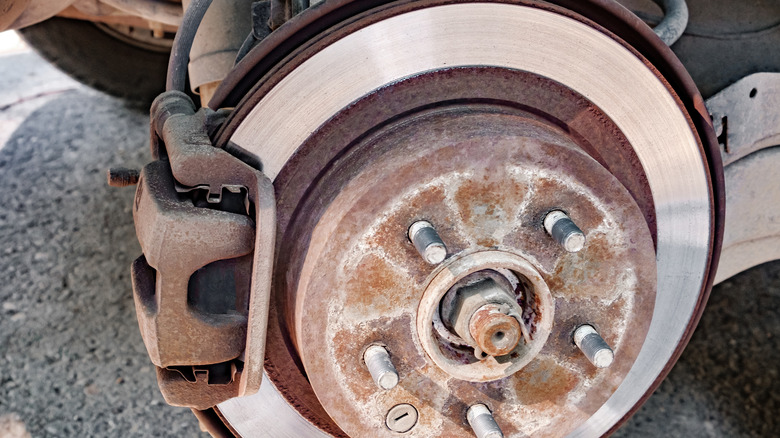How Often Your Brake Rotors Need Replacing (And How To Tell When It's Time)
In an ideal setting where the sky's the limit in terms of budget and labor costs, replacing the brake rotors or brake discs when changing the brake pads is highly recommended. The brake rotors in your car should have a relatively smooth surface, but deep grooves and other imperfections will develop over time or as the brake pads wear out. Pairing new brake pads with old rotors could result in uneven wear and subpar braking performance, since brake pads need a smooth surface to press onto to create the necessary friction and stop the vehicle.
Herein lies a somewhat complicated dilemma: The brake pads will typically wear out quicker than the rotors. Should you replace the brake discs even if they're in relatively good shape? The answer depends on many variables, since it isn't always necessary to replace the rotors when changing the brake pads.
Experts recommend a brake inspection every time your car gets an oil change, and this mainly involves a technician checking the thickness of the brake pads (and rear brake shoes, when applicable) and the smoothness of the rotors. On average, a mostly city-driven car will need a brake pad replacement every 30,000 to 35,000 miles, while vehicles that do a lot of highway duty can have pads lasting as much as 80,000 miles.
If your car's brake rotors feel rough or have visible grooves at, let's say, 35,000 miles, it would be better and safer to replace the rotors when swapping to new brake pads. On average, the brake rotors could last 30,000 to 70,000 miles, depending on the type of car and usage scenarios.
When to replace brake rotors
There's no telling when exactly the brake rotors could fail, wear out, or start developing cracks, rust, or corrosion. Like the brake pads, the rotors will wear out over time –they'll get thinner and less efficient due to intense heat, pressure, and abrasion. Moreover, cast-iron rotors are essentially bare metal discs and will succumb to rust as they age. If the rotors are bad or wearing out, the following symptoms may occur:
- Vibrations or pulsing sensations on the steering wheel and brake pedal when braking.
- Squealing, squeaking, or grinding noises. Take note, these are also the signs that the brake pads need replacing.
- Visible damage, grooves, or scoring on the rotor surface.
- Extreme rust around the rotor edges or biting surfaces,
- Heat spots on the rotor surface, which are bluish or discolored stains due to excess heat and friction.
If you find or notice any of the above symptoms on the brake rotors of your car, it's time to replace them. Brake rotors will cost anywhere from $30 to $75 each, and you can expect to pay $250 to $500 per axle, including labor. However, the servicing costs will depend on the make and model of your car. If the price is a bit of a stretch, resurfacing the brake rotors could be a more affordable option.
When to resurface instead of replacing the brake rotors
Brake rotors have a discard level or minimum thickness, and the numbers are on the hub or the rim itself. The technician will measure this using visual inspection and a micrometer. If the rotor surpasses the minimum thickness after resurfacing, it's better to replace it altogether. Resurfacing involves shaving off a thin layer of the rotor surface using a brake lathe, and this costs around $15 to $40 per rotor. Resurfacing costs significantly less, and they can last 30,000 to 70,000 miles when done right.
The brake discs are relatively durable owing to their cast-iron construction, but neglect plays a significant role in reducing their service life. Using the wrong type of brake pads will wear out the brake discs sooner, and allowing the pads to reach their maximum limit before replacing them will damage the rotor surface. The good news is that you can visually inspect the thickness of the pads without removing the wheel. The rule of thumb is to replace the pads if the friction material is at or under three millimeters thick. Doing so will prevent scarring and extend the life of the brake rotors.


